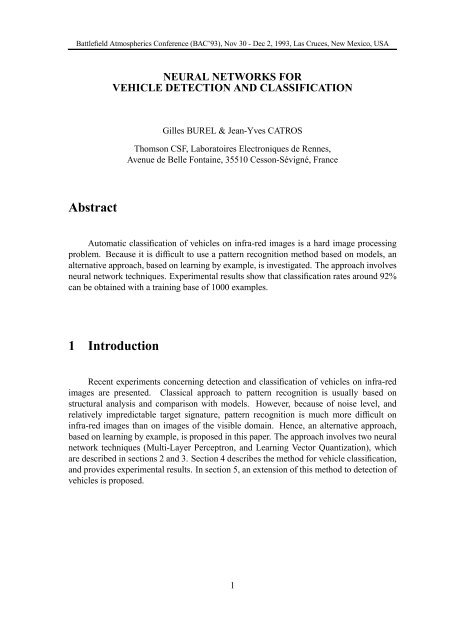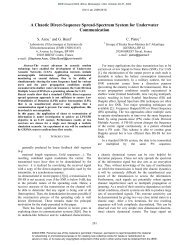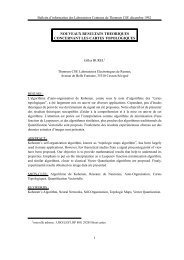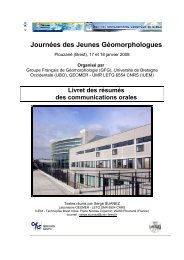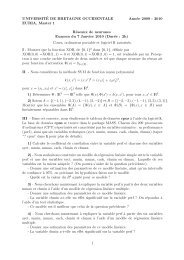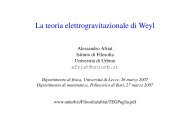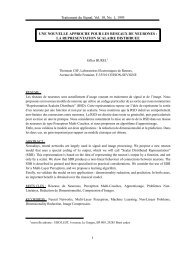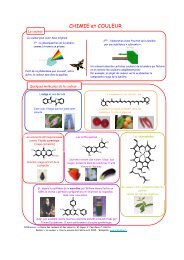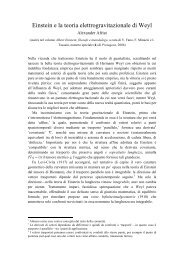Abstract 1 Introduction
Abstract 1 Introduction
Abstract 1 Introduction
Create successful ePaper yourself
Turn your PDF publications into a flip-book with our unique Google optimized e-Paper software.
Battleeld Atmospherics Conference (BAC’93), Nov 30 - Dec 2, 1993, Las Cruces, New Mexico, USA<br />
NEURAL NETWORKS FOR<br />
VEHICLE DETECTION AND CLASSIFICATION<br />
Gilles BUREL & Jean-Yves CATROS<br />
Thomson CSF, Laboratoires Electroniques de Rennes,<br />
Avenue de Belle Fontaine, 35510 Cesson-Sévigné, France<br />
<strong>Abstract</strong><br />
Automatic classication of vehicles on infra-red images is a hard image processing<br />
problem. Because it is difcult to use a pattern recognition method based on models, an<br />
alternative approach, based on learning by example, is investigated. The approach involves<br />
neural network techniques. Experimental results show that classication rates around 92%<br />
can be obtained with a training base of 1000 examples.<br />
1 <strong>Introduction</strong><br />
Recent experiments concerning detection and classication of vehicles on infra-red<br />
images are presented. Classical approach to pattern recognition is usually based on<br />
structural analysis and comparison with models. However, because of noise level, and<br />
relatively impredictable target signature, pattern recognition is much more difcult on<br />
infra-red images than on images of the visible domain. Hence, an alternative approach,<br />
based on learning by example, is proposed in this paper. The approach involves two neural<br />
network techniques (Multi-Layer Perceptron, and Learning Vector Quantization), which<br />
are described in sections 2 and 3. Section 4 describes the method for vehicle classication,<br />
and provides experimental results. In section 5, an extension of this method to detection of<br />
vehicles is proposed.<br />
1
Battleeld Atmospherics Conference (BAC’93), Nov 30 - Dec 2, 1993, Las Cruces, New Mexico, USA<br />
2 The Multi-Layer Perceptron<br />
The Multi-Layer Perceptron is a popular neural network model, which has been<br />
succesfully used in a variety of image processing and pattern recognition applications. The<br />
Multi-Layer Perceptron is trained by the backpropagation algorithm [3]. An example of<br />
such a neural network structure is shown on gure 1. The neuron model is shown on gure<br />
2. It is a weighted summator followed by a non-linear function. First, the neuron’s potential<br />
X j is computed as weighted sum of its inputs O i : X j i W ijO i . Then, the neuron’s<br />
output O j is computed as a non-linear function of its potential: O j FX j tanhX j .<br />
Adding special neurons, called “threshold neurons”, whose output is always 1, improves<br />
the performances of the network.<br />
output vector<br />
input vector<br />
neuron<br />
threshold neuron<br />
input unit<br />
Figure 1: An example of Multi-Layer Perceptron<br />
For instance, for a 3 classes problem, there are 3 neurons on the output layer (one for<br />
each class), and the desired output values are:<br />
1 1 1 for class 1<br />
1 1 1 for class 2<br />
1 1 1 for class 3<br />
2
Battleeld Atmospherics Conference (BAC’93), Nov 30 - Dec 2, 1993, Las Cruces, New Mexico, USA<br />
O<br />
i<br />
W<br />
ij<br />
X<br />
j<br />
F<br />
O<br />
j<br />
Figure 2: The neuron model<br />
Let us note E the mathematical expectancy. The learning algorithm adjusts the<br />
weights in order to provide correct outputs when examples extracted (in a random order)<br />
from a training set are presented on the network input layer. To perform this task, a mean<br />
square error is dened as:<br />
where<br />
e S <br />
<br />
output neurons<br />
e MS Ee S <br />
1<br />
obtained output desired output2<br />
2<br />
Let us note g ij e S<br />
, S j the desired outputs, and O j the obtained outputs. It has been<br />
W ij<br />
proved [3]<br />
<br />
that g ij j O i ,where<br />
j O j S j F X j when j is on the output layer,<br />
<br />
and j <br />
k W jk F X j when j is on another layer. Since the examples are<br />
successors j<br />
extracted in random order (and provided that the training set is signicant), the gradient of<br />
e MS can be approximated by low pass ltering of g ij :<br />
g ij t 1 g ij t g ij t 1<br />
The backpropagation algorithm performs a gradient descent according to:<br />
W ij t g ij t<br />
Once learning is achieved, the network can deal with new data.<br />
the neuron whose output value is the highest determines the class.<br />
For classication,<br />
Acondence measure (between 0 and 1) can also be dened as :<br />
condence = 1 2<br />
( highest output - second highest output )<br />
3
Battleeld Atmospherics Conference (BAC’93), Nov 30 - Dec 2, 1993, Las Cruces, New Mexico, USA<br />
3 Learning Vector Quantization<br />
Learning Vector Quantization is a neural network algorithm proposed by Kohonen<br />
[2], which involves 2 main steps:<br />
Unsupervised representation of the data, using the Topological Maps model.<br />
Supervised ne tuning of the neural network.<br />
3.1 The Topological Maps<br />
The Kohonen network, also known as the “topologic maps model”, is inspired from<br />
a special structure found in some cortex areas (g 3). The neurons are organized in<br />
layers, and, inside a layer, each neuron sends excitatory connections towards its nearest<br />
neighbours, and inhibitory connections towards the other neurons. All neurons receive the<br />
same inputs from the external world.<br />
outputs<br />
Figure 3: The topologic maps model (1D)<br />
inputs<br />
Kohonen simulated the behaviour of this kind of neural network [1], and showed<br />
that it can be approximated by the following algorithm. Let us consider a network with<br />
M neurons, and let us note K the number of inputs, and x [x 1 x 2 x K ] T an input<br />
4
Battleeld Atmospherics Conference (BAC’93), Nov 30 - Dec 2, 1993, Las Cruces, New Mexico, USA<br />
vector. The input vectors are extracted from a set A, called “the learning set”. This<br />
set contains cardA vectors. Each neuron is characterized by a vector of weights<br />
W j [W 1 j W Kj ] T ,where j is the index of the neuron. In response to an input vector x,<br />
the neuron such that the quadratic distance W j x 2 is minimal is called the winner. We<br />
will note O j the output of neuron j:<br />
O j W j x 2 <br />
K<br />
W ij x i 2<br />
i1<br />
The learning algorithm is the following (t is the iteration index, and T is the total<br />
number of iterations):<br />
1. t 0<br />
Initialization of the weight vectors W 1 W 2 W M <br />
2. n 1<br />
Let be a random permutation of the set 1 2 cardA<br />
3. Presentation of the vector xn on input.<br />
4. Computation of neurons outputs O j<br />
5. Determination of the winner (neuron k which provides the lowest output)<br />
6. Modication of the weights according to:<br />
7. n n 1<br />
If n cardA,goto(3)<br />
8. t=t+1<br />
If t T go to (2)<br />
W j jk t[x W j ]<br />
The coefcients jk t are of the form t d j k. The distance d denes the dimension<br />
of the network. For 1D networks arranged in ring, such as the one we used for our<br />
application, we have d j k min j k M j k.Weproposetouse:<br />
jk t 0 e d2 jk<br />
2t<br />
2<br />
The constant 0 is called “the learning rate”. Kohonen suggests values around 10 1 .The<br />
standard deviation t decreases with t according to an exponential rule:<br />
t<br />
T 1<br />
T 1<br />
t 0<br />
0<br />
5
Battleeld Atmospherics Conference (BAC’93), Nov 30 - Dec 2, 1993, Las Cruces, New Mexico, USA<br />
It is clear that, at each step, the winner and its neighbours will move their weights<br />
in direction of the input vector x. Hence, the network’s dynamics could be seen as the<br />
result of an external force (adaptation to input vectors), and an internal force (the neighbourhood<br />
relations, that force nearby neurons to have close weights). Kohonen validated<br />
his algorithm on speech data, and showed that the neurons organize their weights in order<br />
to become representative of phonemes. Furthermore, topological relations are preserved<br />
(close neurons react to close phonemes).<br />
y<br />
Figure 4: Self-organization inside a triangle<br />
Properties of Kohonen’s algorithm may be illustrated on a simple example. Let us<br />
assume that the input vectors are of dimension 2, and that their components are coordinates<br />
of a point randomly selected inside a triangle. Each neuron has two weights, so we can<br />
represent it by a point in the 2D plane. Figure 4 shows the network state after learning.<br />
Hence, the neural network, that can be seen as a one dimensional curve, has performed an<br />
approximation of a 2D domain (the triangle).<br />
Kohonen’s algorithm may be easily generalized to higher network’s dimensions. For<br />
example, a 2D network is shown on gure 5.<br />
x<br />
6
Battleeld Atmospherics Conference (BAC’93), Nov 30 - Dec 2, 1993, Las Cruces, New Mexico, USA<br />
neuron<br />
neighbourhood<br />
inputs<br />
Figure 5: Topologic maps model (2D)<br />
3.2 Supervised ne tuning of the neural network<br />
Starting from a topological map which has converged, a class is assigned to each<br />
neuron by majority voting (among the examples for which this neuron is the winner).<br />
Then, the network is tuned in order to improve its classication accuracy. Kohonen has<br />
proposed 3 methods (LVQ1, LVQ2, LVQ3) for ne tuning. LVQ2 is supposed to be an<br />
improved version of LVQ1, and LVQ3 an improved version of LVQ2, although, for some<br />
applications, LVQ1 may provide the best results.<br />
3.2.1 LVQ1<br />
The examples are presented randomly and, for each example, the weights of the<br />
winner ( j)aretunedasbelow(c is the class of the example):<br />
W j x W j <br />
W j x W j <br />
if c j<br />
if c j<br />
7
Battleeld Atmospherics Conference (BAC’93), Nov 30 - Dec 2, 1993, Las Cruces, New Mexico, USA<br />
3.2.2 LVQ2<br />
Let us note j the winner, and k the next-to-nearest neuron. Let us note also<br />
d j x W j and d k x W k . If the class assigned to k is the same as the class of<br />
x, and is different to the class assigned to j, andifd k sd j (s 12), then:<br />
W j x W j <br />
W k x W k <br />
3.2.3 LVQ3<br />
If the class assigned to k is the same as the class of x, and is different to the class<br />
assigned to j, andifd k sd j (s 12), then:<br />
W j x W j <br />
W k x W k <br />
If x, j, k, belong to the same class, then:<br />
W j x W j <br />
W k x W k <br />
4 Classication<br />
Classication of vehicles on infra-red images leads to serious difculties, due to the<br />
following variabilities:<br />
The background is unknown.<br />
The meteorological conditions are uncontrolled.<br />
The orientation of the vehicle with respect to the camera is unknown.<br />
8
Battleeld Atmospherics Conference (BAC’93), Nov 30 - Dec 2, 1993, Las Cruces, New Mexico, USA<br />
The including frame provided by a detector is approximate, hence there may be slight<br />
variations of the apparent size of the vehicle.<br />
These variabilities are taken into account by creating a large training base, containing<br />
various vehicles in many orientations, with many backgrounds and environmental conditions.<br />
Furthermore, to take into account the fact that the including frame is approximate,<br />
slight homotheties are performed on the examples of this data base.<br />
The image to classify is normalized in mean and variance, in order to obtain some<br />
insensibility with respect to camera gain. Then it is normalized in size, because the input<br />
size of a neural network is xed. For our experiments, this size was 24x16pixels.<br />
Six classes of vehicles have been dened: helicopter, truck, and four classes of tanks.<br />
A data base of 945 images of vehicles has been created to train the neural network. A<br />
second data base of 1407 images of vehicles has been created to test the generalization<br />
capabilities of the neural network (these images are not used for training).<br />
Two kinds of neural networks have been compared:<br />
A 3-layer perceptron (384 + 15 + 6 neurons), trained by the backpropagation algorithm<br />
A LVQ network (384 inputs, 32 neurons). The LVQ1 method for ne tuning has been<br />
used.<br />
The obtained generalization rate is:<br />
92% with the 3-layer perceptron<br />
89% with the LVQ network<br />
The required training time (on a Sun workstation) is 10 hours for the 3-layer<br />
perceptron and 30mn for the LVQ network. Classication of a normalized image requires<br />
385x15+16x6 = 5871 multiplications with the 3-layer perceptron, and 384x32 = 12288<br />
multiplications with the LVQ network.<br />
The conclusion is that the performances of these neural networks are quite similar<br />
(92% and 89%), but the MLP is twice faster at recognition. However, since the training<br />
time required by the LVQ network is 20 times lower than the training time required by the<br />
MLP, the LVQ network should be used preferently if one wants to compare quickly the<br />
interest of new training bases.<br />
9
Battleeld Atmospherics Conference (BAC’93), Nov 30 - Dec 2, 1993, Las Cruces, New Mexico, USA<br />
Figure 6 shows the weights of the LVQ network after training. Although the weights<br />
are difcult to interpret, one may recognize patterns similar to helicopters, trucks, and<br />
tanks by careful examination of this image.<br />
Figure 6: Weights of the LVQ network<br />
5 Detection<br />
The approach may be extended to vehicle detection by considering that detection is<br />
some kind of classication problem, where the classes are “vehicle” and “background”.<br />
However, a specic difculty must be stressed: we do not know the distance between the<br />
vehicle and the camera. Hence, the apparent size of the vehicle on the image is unknown.<br />
The proposed approach consists in scanning the image at various resolutions. For<br />
each location and size of the scanning window, the window content is normalized in mean<br />
and variance, then normalized in size, and nally propagated through a neural network.<br />
10
Battleeld Atmospherics Conference (BAC’93), Nov 30 - Dec 2, 1993, Las Cruces, New Mexico, USA<br />
The neural network provides a class (vehicle or background), and a condence associated<br />
to this decision.<br />
All the local decisions are then fused to suppress multiple detections at close spatial<br />
locations. To achieve this task, we search for the strongly overlapping detections. Two<br />
detections are considered as strongly overlapping if the center of one window is included<br />
in the other window. For such congurations, we suppress the detection which has the<br />
lower condence.<br />
For experimentation, we have created a training base of 4647 images (1407 images<br />
of vehicles and 3240 images of backgrounds). It is good to have more backgrounds than<br />
vehicles in the training base, in order to keep the false alarm rate at a low level. MLP<br />
and LVQ networks provide comparable results. On a typical test sequence showing 3<br />
tanks moving at various distances, the 3 vehicles are detected almost on each image of the<br />
sequence, while two or three false alarms may appear stealthy. Since the location of these<br />
false alarms seem to be almost random, they might be suppressed by temporal analysis.<br />
6 Conclusion<br />
An approach to vehicle detection and classication on infra-red images has been<br />
proposed in this paper. The approach is based on learning by example and neural network<br />
techniques. Concerning classication, 6 classes have been dened: helicopter, truck,<br />
and 4 classes of tanks. A neural network has been trained to recognize these classes<br />
independently of vehicle orientation and environment conditions. Two kinds of neural<br />
networks have been compared: the multi-layer perceptron and Kohonen’s learning vector<br />
quantization. Experimental results obtained on 1400 examples show that a classication<br />
rate of 92% can be expected. An extension of this approach for detection purpose has been<br />
proposed. The image is analysed by multi-resolution scanning. For each resolution and<br />
each window location, the content of the window is normalized in size, average brightness,<br />
and contrast. Then, it is propagated through a neural network, which provides a decision<br />
(“vehicle” or “background”) and a condence measure. All the decisions are then fused<br />
across the various resolutions in order to suppress multiple detections at the same location.<br />
The fusion is based on analysis of condence.<br />
References<br />
[1] T. Kohonen, “Self-Organization and Associative Memory”, Springer-Verlag, 1984<br />
11
Battleeld Atmospherics Conference (BAC’93), Nov 30 - Dec 2, 1993, Las Cruces, New Mexico, USA<br />
[2] T. Kohonen, “The Self-Organizing Map”, Proc. of IEEE, vol 78, n o 9, pp 1465-1481,<br />
September 1990<br />
[3] D.E. Rumelhart, G.E. Hinton, R.J. Williams, “Learning internal representations by error<br />
backpropagation”, In Parallel Distributed Processing, D.E. Rumelhart and J.L. Mc<br />
Clelland, Chap 8, Bradford Book - MIT Press - 1986<br />
12


